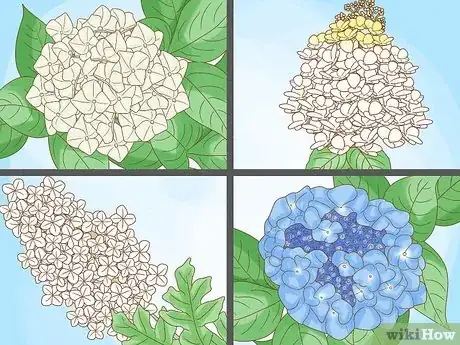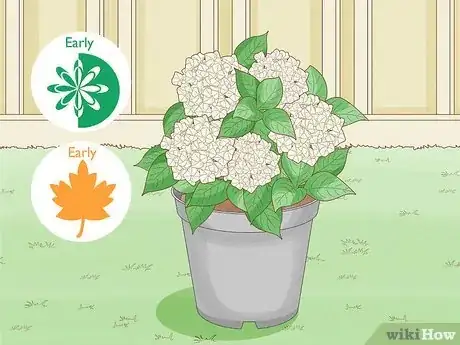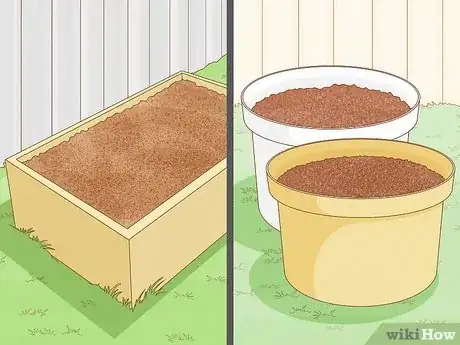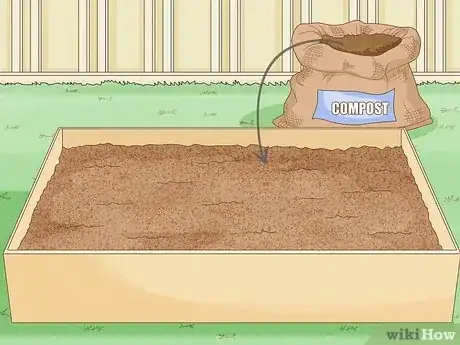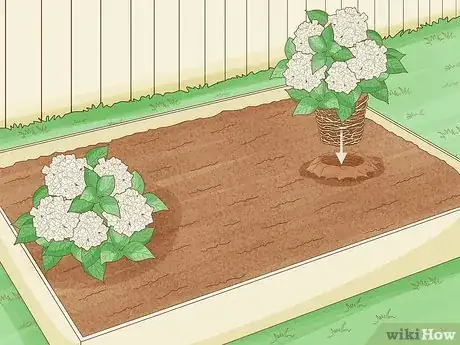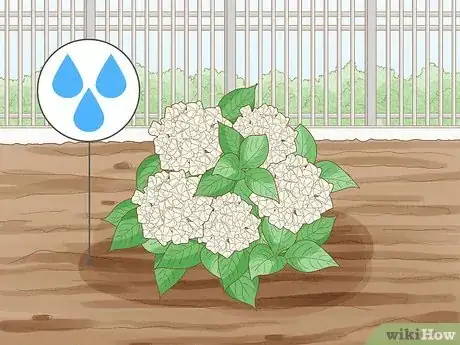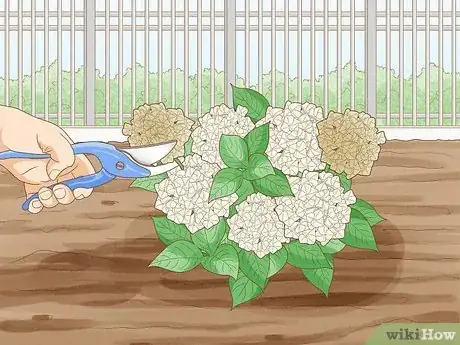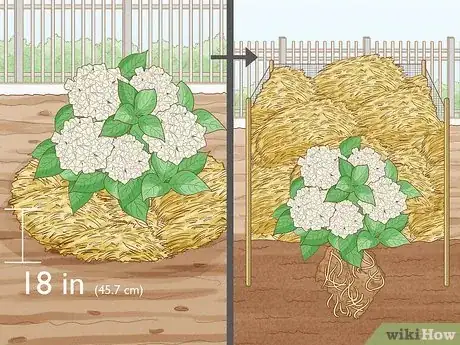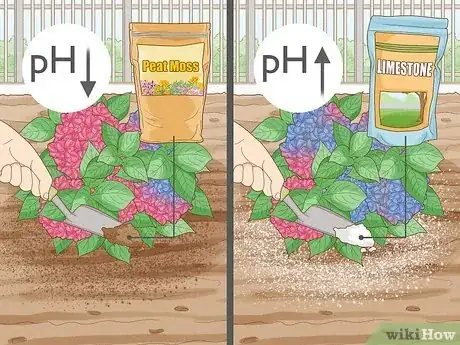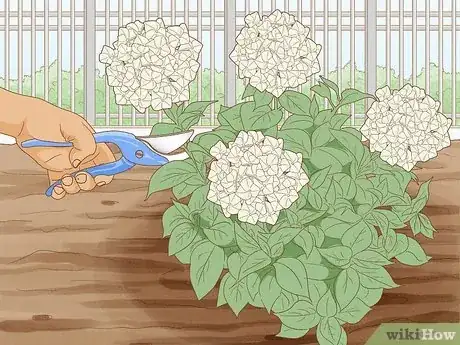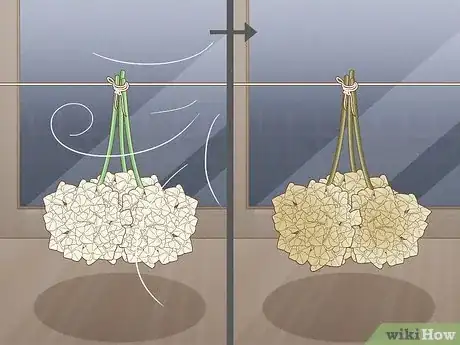This article was co-authored by Lauren Kurtz. Lauren Kurtz is a Naturalist and Horticultural Specialist. Lauren has worked for Aurora, Colorado managing the Water-Wise Garden at Aurora Municipal Center for the Water Conservation Department. She earned a BA in Environmental and Sustainability Studies from Western Michigan University in 2014.
wikiHow marks an article as reader-approved once it receives enough positive feedback. In this case, 100% of readers who voted found the article helpful, earning it our reader-approved status.
This article has been viewed 154,780 times.
From mid-summer to early fall, you don't have to look far to find beautiful hydrangea bushes growing in flower gardens, around fence borders and in front yards. These perennials produce large clusters of small flowers in varying shades of pink, blue, purple, white or a combination of colors that last well into autumn. Read on to learn how to plant, care for and dry hydrangeas so you can enjoy them all year round.
Steps
Planting Hydrangeas
-
1Choose a hydrangea variety. In order to figure out what type of hydrangea to plant, you'll need to figure out which variety is best for your gardening zone. Start by looking at a planting zone hardiness map[1] to determine the number of your zone. There are hundreds of varieties of hydrangeas to choose from. If this is your first time planting these beautiful flowers, you may want to choose from among these common varieties that are known to be hardy and produce long-lasting blooms.[2] [3]
- Mophead and lacecap hydrangeas, or "bigleaf" hydrangeas, don't do as well in colder regions unless you take measures to protect them from frost. Look for the "Endless Summer" mop-head variety at your local nursery - it's a type of mophead hydrangea that blooms more than once over the summer. This type of hydrangea produces large balls of pink or blue blossoms that deepen in color over the course of the season.
- The oakleaf hydrangea grows well in places with very hot summers without too much moisture. It is hardy through zone 4b/5a. This type of hydrangea has white blossoms.
- Annabelle hydrangeas are more cold hardy than mophead or oakleaf hydrangeas, can still grow in zone 3. This type of hydrangea has white blossoms that turn light green later in the season.
- Peegee hydrangeas can grow hardy even further north than Annabelles - all the way up to zone 3a. They are also able to grow in southern zones. They have white blossoms.
-
2Plan to plant in the spring or fall. Planting in one of these milder seasons will give the hydrangeas time to acclimate to the soil conditions and take root before the weather gets more extreme. Look for hydrangea plants in your nursery in early spring or early fall.[4]Advertisement
-
3Find a good planting spot. Hydrangeas are easy to grow either in planting beds or in large pots. Whichever method you choose, you'll need a spot that gets full sun in the morning and partial shade in the afternoon. Bigleaf hydrangeas will grow in complete partial shade, so choose this variety if you have a shady yard.[5]
-
4Enrich the soil with compost. Hydrangeas need rich, well-drained soil that is kept moist. If you're working with dry or depleted soil, get it ready for hydrangeas by working in some compost. If your soil tends to hold water, you can add peat to help with drainage.
-
5Dig a wide hole in the soil. The hold you dig should be as deep as the root ball on the hydrangea plant, and at least twice as wide. Use a spade or shovel to dig a big hole to accommodate the plant's roots. If you're planting more than one hydrangea, they should be spaced 5–7 feet (1.5–2.1 m) apart, since the plants can grow to get very large.
- Check the instructions that came with your particular hydrangea variety. Some hydrangeas can be planted closer together, while others may need to be planted at least 10 feet (3.0 m) apart.[6]
-
6Plant the hydrangea. It's important to make sure the roots of the hydrangea get watered at the time of planting, so start by setting the hydrangea's root ball in the hole you dug. Fill the hole with soil and then give it water. Pat the soil down around the base of the hydrangea.
- Planting hydrangeas too deeply can cause the roots to fail. If not planted deep enough, your hydrangeas could fall over in heavy rain or strong wind.
Caring for Hydrangeas
-
1Keep the soil moist. Hydrangeas will begin to wilt if the soil gets too dry, so make sure you water them every day or two, especially during the hot summer months. Water the hydrangeas near the base of the plants and above the roots, rather than spraying the water directly onto the flowers; this prevents the flowers from getting burned by the sun.
-
2Prune only when necessary. New hydrangeas do not need to be pruned; if you do so, you may not get new blossoms the following spring. If you have older hydrangeas that have gotten quite large and need to be cut back, make sure you prune at the right time of year according to the variety of hydrangea you planted.
- Bigleaf hydrangea varieties should be pruned after the blossoms have faded in the late summer.
- Pee Gee Hydrangea (H. paniculata), also known as Panicle, are best pruned in late winter or early spring or fall. This variety blooms on the current season’s wood, so go easy on pruning. Don’t cut to the ground unless your bush is getting too big.
- Annabelle Hydrangea (H. arborescens) can be lightly pruned in the summer after the spring bloom, or cut down to the ground in late winter.
- Oakleaf and other hydrangeas that bloom on the current season's wood should be pruned while the plant is still dormant, in late winter or early spring, before the blooms emerge.[7]
-
3Protect hydrangeas over the winter. Cover them with mulch, straw, or pine needles to a depth of at least 18 inches (45.7 cm). If you have smaller bushes, you can cover the entire plant for the winter. Remove the cover in early spring, after the last frost. Use chicken wire or some other small fence like cage to help mulch stay around plant’s crown.
-
4Change the color of hydrangeas. The color of hydrangeas depends on the pH of the soil in which they are planted. If you have pink or blue hydrangeas, it's possible to change their color by changing the soil's pH. This can take weeks or months, so be patient!
- Wait until your plant has been in the garden at least two years before attempting color change.
- To change flowers from pink to blue, lower the soil's pH by adding sulfur or peat moss. To change flowers from blue to pink (which is more difficult than changing from pink to blue), add limestone to the soil to raise the soil's pH. White hydrangea blossoms don't change color.
- Gently mix in soil amendments into the first few inches of soil around your plant’s roots.
Cutting and Drying Hydrangeas
-
1Harvest hydrangeas when the flowers are mature. Wait until the color is rich and the flowers have a papery, rather than juicy, consistency. This will make the flowers easier to dry. Use a scissors or pruning tool to cut the stems.
-
2Dry hydrangeas to preserve them. Hydrangeas preserve beautifully when dried. Their color stays bright for a long time, and they hold their shape for years before disintegrating. To dry hydrangeas, use one of the following methods:
- Hang them upside down. Tape or pin the stems to the top of a doorway in a dry, dark room. Let them hang until they completely dry, then remove them and arrange them in a vase.
- Dry them in water. Place the stems in a vase filled with a few inches of water. Allow the flowers to slowly dry as the water evaporates.
- Use silica gel. Place the blossoms in a container and cover completely with silica gel. After a week or two, the flowers will be dry, their color perfectly preserved.
Expert Q&A
Did you know you can get expert answers for this article?
Unlock expert answers by supporting wikiHow
-
QuestionWhat is the best fertilizer for hydrangeas?
 Maggie MoranMaggie Moran is a Professional Gardener in Pennsylvania.
Maggie MoranMaggie Moran is a Professional Gardener in Pennsylvania.
Home & Garden Specialist
-
QuestionDo hydrangeas need ericaceous soil?
 Laura MartinLaura Martin is a Licensed Cosmetologist in Georgia. She has been a hair stylist since 2007 and a cosmetology teacher since 2013.
Laura MartinLaura Martin is a Licensed Cosmetologist in Georgia. She has been a hair stylist since 2007 and a cosmetology teacher since 2013.
Licensed Cosmetologist
-
QuestionHow do you grow hydrangeas from cuttings?
 Maggie MoranMaggie Moran is a Professional Gardener in Pennsylvania.
Maggie MoranMaggie Moran is a Professional Gardener in Pennsylvania.
Home & Garden Specialist
Warnings
- When planting hydrangeas, wait until the chance for frost has passed, and avoid planting them during the hottest days of summer.⧼thumbs_response⧽
- Hydrangeas will not thrive or bloom if you plant them in a very shady area where they get little or no sun.⧼thumbs_response⧽
- Do not over-water hydrangeas. Too much moisture can cause the plants to produce less blooms or make the roots rot.⧼thumbs_response⧽
- Do not let the soil around your newly-planted hydrangeas dry out. Check the plants regularly if the weather gets hot and dry, and water accordingly.⧼thumbs_response⧽
Things You'll Need
- Hydrangea plants
- Shovel or spade
- Mulch
- Pruning shears
References
- ↑ http://www.naturehills.com/plant-zone-map
- ↑ http://www.bhg.com/gardening/trees-shrubs-vines/shrubs/hydrangea-guide/
- ↑ https://www.gardeningknowhow.com/ornamental/shrubs/hydrangea/prune-hydrangea-bushes-hydrangea-pruning-instructions.htm
- ↑ https://www.gardeningknowhow.com/ornamental/shrubs/hydrangea/growing-hydrangeas-hydrangea-care-guide.htm
- ↑ https://www.gardeningknowhow.com/ornamental/shrubs/hydrangea/growing-hydrangeas-hydrangea-care-guide.htm
- ↑ http://www.almanac.com/plant/hydrangea
- ↑ https://www.gardeningknowhow.com/ornamental/shrubs/hydrangea/growing-hydrangeas-hydrangea-care-guide.htm
About This Article
To grow hydrangeas, start by choosing a hydrangea variety based on your climate zone. If you live in a colder region, for example, go with varieties like Annabelle or Peegee. Then, plant your hydrangeas in the spring or fall so they have time to acclimate to the soil before the weather gets more extreme. Once you’ve chosen your spot, dig a hole as deep as the root ball on the hydrangea plant, and at least twice as wide. Afterwards, set the plant’s root ball in the hole, fill the hole with soil, and water near the base of the plant until the soil is moist. For more advice from our Horticulturist reviewer, including how to care for your hydrangeas after planting, keep reading.
